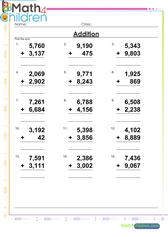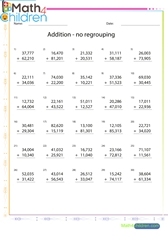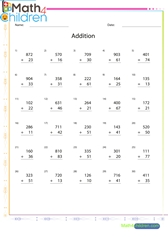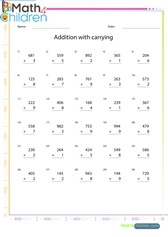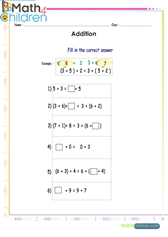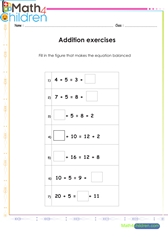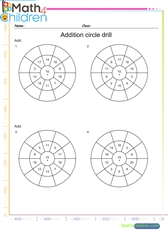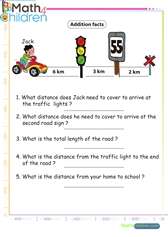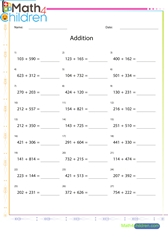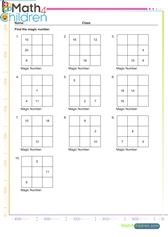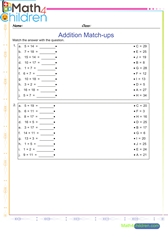![]()
Addition and Subtraction Worksheets
Addition and subtraction are foundational mathematical skills that are essential for everyday life. They form the basis for more advanced mathematical concepts and are crucial for problem-solving in various situations. Addition and subtraction worksheets provide a structured way for learners to practice and master these skills. Let's explore the significance of addition and subtraction worksheets and how they contribute to effective learning.
Additio of 5 plus 5 digit numbers
Additio of 5 plus 5 digit numbers printable math worksheet
Addition and balancing equations
Addition and balancing equations printable math worksheet
Addition horizontally arranged numbers
Addition horizontally arranged numbers printable math worksheet
Subtraction of numbers with regrouping game online
Importance of Addition and Subtraction Skills
Addition and subtraction are fundamental mathematical operations that serve as the building blocks for all other mathematics. The importance of mastering these skills cannot be overstated, as they are crucial for both academic and everyday life. Here are some key points that highlight the significance of addition and subtraction skills:
-
Foundation for Advanced Mathematics: Addition and subtraction are the preliminary steps towards understanding more complex mathematical concepts and operations such as multiplication, division, algebra, and calculus. A solid grasp of these basic operations is essential for progressing in mathematics.
-
Critical Thinking and Problem-Solving: Learning addition and subtraction enhances critical thinking and problem-solving skills. These operations require logic, pattern recognition, and the application of various strategies, which are vital cognitive skills applicable across numerous disciplines.
-
Everyday Applications: From budgeting money to measuring ingredients in cooking, addition and subtraction are integral to daily life activities. These skills enable individuals to make informed decisions, manage their time and resources effectively, and navigate everyday tasks with ease.
-
Numerical Fluency: Proficiency in addition and subtraction contributes to numerical fluency, where individuals can manipulate numbers with ease and confidence. This fluency is crucial for academic success in various subjects and practical life scenarios.
-
Enhances Memory and Cognitive Function: Practicing these operations can improve memory and cognitive functions. The mental calculation involves retaining numbers in short-term memory, while strategizing solutions exercises cognitive flexibility and enhances mental arithmetic skills.
-
Building Confidence: Mastery of addition and subtraction can significantly boost a student's confidence in their mathematical abilities, encouraging them to engage more deeply with the subject and tackle more challenging problems.
-
Analytical Skills: These basic mathematical operations help develop analytical skills. Understanding how to construct and deconstruct numbers through addition and subtraction is fundamental to analyzing data, patterns, and relationships in math and science.
-
Educational Requirements: Mathematics is a core subject in educational curricula worldwide. Competency in addition and subtraction is not only a requirement for progressing in school but also a necessity for standardized tests and assessments.
-
Supports Other Learning Areas: Mathematical skills are not confined to math class; they support learning in science, technology, engineering, economics, and various other fields. For example, understanding scientific measurements, data analysis, and technological calculations all require basic arithmetic skills.
-
Lifetime Utility: The skills learned in addition and subtraction are not just for school—they are lifelong tools. Financial management, time planning, and even understanding sports scores or cooking all rely on these essential arithmetic operations.
In essence, addition and subtraction are more than just mathematical skills; they are essential tools that empower individuals to navigate both academic pursuits and everyday life with greater efficacy and confidence.
Benefits of Learning Addition and Subtraction:
- Enhances problem-solving abilities
- Promotes mental math skills
- Builds confidence in mathematical abilities
- Facilitates understanding of mathematical concepts
Types of Addition and Subtraction Worksheets
There are various types of addition and subtraction worksheets tailored to different skill levels and learning objectives.
Basic Addition and Subtraction Worksheets:
These worksheets are designed for beginners and focus on simple addition and subtraction problems without regrouping.
Regrouping (Carrying and Borrowing) Worksheets:
Regrouping worksheets introduce students to carrying and borrowing techniques necessary for solving larger addition and subtraction problems.
Word Problem Worksheets:
Word problem worksheets present addition and subtraction challenges in real-life contexts, encouraging students to apply mathematical concepts to practical situations.
How to Use Addition and Subtraction Worksheets Effectively
To maximize the effectiveness of addition and subtraction worksheets, parents and teachers can implement various strategies.
Tips for Parents and Teachers:
- Provide clear instructions and examples
- Offer encouragement and praise for effort
- Incorporate hands-on activities and manipulatives
- Monitor progress and provide feedback
Interactive and Digital Addition and Subtraction Worksheets
In today's digital age, there is a growing availability of interactive and digital addition and subtraction worksheets. These resources offer engaging multimedia experiences that cater to different learning styles and preferences.
Customization and Personalization in Worksheets
Customizable worksheets allow educators to tailor exercises according to individual student needs and learning objectives. Personalized worksheets address specific skill gaps and provide targeted practice opportunities.
Incorporating Fun and Games into Learning
Incorporating fun and games into learning, particularly in the context of mathematics, can significantly enhance students' engagement and understanding. Here are some strategies and benefits of using games to teach concepts like addition and subtraction:
-
Interactive Games: Utilize interactive games that allow children to practice addition and subtraction in a playful context. Games can be digital or physical and should be designed to reinforce these concepts through repetition and incremental challenges.
-
Board Games: Introduce board games that require counting, adding, or subtracting as part of the game mechanics. For example, games where players move pieces based on dice rolls can help with quick addition and understanding number sequences.
-
Card Games: Use card games where players have to add or subtract card values to make specific numbers. This encourages mental arithmetic and helps in memorizing basic facts.
-
Puzzles: Employ puzzles that require solving addition and subtraction problems to complete. These can be jigsaw puzzles with numbers or interactive online puzzles that blend problem-solving with math practice.
-
Role-Playing: Create scenarios where children can role-play shopping, banking, or other real-life situations where they need to use addition and subtraction. This contextual learning helps students see the practical value of math.
-
Math Trails: Organize math trails in the school or local area where students follow a route, solving addition and subtraction problems along the way. This combines physical activity with learning.
-
Math Stations: Set up different stations with various math games and activities. Rotating through stations can keep the learning experience fresh and engaging for students.
-
Technology Integration: Incorporate educational apps and online games that focus on addition and subtraction. These tools often provide instant feedback, which is crucial for learning.
-
Creative Arts: Integrate math with art or music. For example, students can create artwork based on addition and subtraction patterns or compose simple rhythms that illustrate mathematical principles.
-
Competitions: Host friendly competitions where students solve addition and subtraction problems. This can motivate students to improve their skills while fostering a sense of community.
Benefits of Using Fun and Games in Learning:
- Enhanced Engagement: Games make learning more enjoyable, increasing students' willingness to participate and focus.
- Stress Reduction: Incorporating play reduces anxiety around learning, making students more receptive to new concepts.
- Practical Application: Games can demonstrate the real-world application of math, making the learning more relevant and meaningful.
- Instant Feedback: Many games provide immediate feedback, helping students quickly understand their mistakes and learn from them.
- Social Learning: Games often encourage interaction, promoting social skills and collaborative learning.
By blending fun and educational content, teachers can create a more dynamic and effective learning environment that caters to various learning styles and preferences, making the acquisition of foundational mathematical skills like addition and subtraction more engaging and effective.
Tracking Progress with Worksheets
Regular assessment and tracking of progress are essential components of effective learning. Addition and subtraction worksheets enable educators to monitor students' proficiency levels and identify areas for improvement.
Challenges Faced in Learning Addition and Subtraction
Learning addition and subtraction is a fundamental aspect of early mathematics education, serving as the building blocks for more complex mathematical concepts. However, students, particularly young learners, often face various challenges when acquiring these skills. Here are some common challenges in learning addition and subtraction:
-
Understanding the Concept of Numbers: Before students can effectively learn addition and subtraction, they need a solid understanding of what numbers represent. This includes recognizing numbers, understanding their order, and grasping the idea that numbers can be used to quantify objects.
-
Number Sense: Developing a strong number sense is crucial for addition and subtraction. This involves an intuitive understanding of numbers, their relationships, and how they can be manipulated. A weak number sense can make it difficult to grasp these operations and their outcomes.
-
Learning the Operations: Addition and subtraction each have their own rules and procedures. Students need to understand these operations conceptually, not just as abstract procedures. This includes grasping that addition is about combining quantities and subtraction is about taking away.
-
Counting Skills: In the early stages, children often rely on counting to perform addition and subtraction. Challenges can arise if their counting skills are not strong, leading to errors and confusion.
-
Memorization of Basic Facts: As students advance, they are expected to memorize basic addition and subtraction facts. Difficulty in memorization can slow down their ability to perform these operations quickly and accurately.
-
Transition from Concrete to Abstract: Initially, students learn addition and subtraction using concrete objects or visual aids. Moving from this concrete understanding to more abstract representations (like written numbers) can be challenging for some students.
-
Word Problems: Applying addition and subtraction in the context of word problems requires not just mathematical skills but also reading comprehension and the ability to translate a narrative into a mathematical equation.
-
Confusion Between Operations: Young learners often confuse addition and subtraction symbols and their associated operations. This confusion can lead to mistakes in calculation.
-
Place Value Understanding: As students move on to adding and subtracting larger numbers, a solid understanding of place value becomes essential. Without it, they can struggle with alignment of numbers and understanding how to carry or borrow.
-
Math Anxiety: Fear of math can affect a student’s ability to learn and perform mathematical operations. Anxiety can interfere with the cognitive processes needed to understand and solve mathematical problems.
Overcoming these challenges requires a supportive learning environment, practice, and sometimes individualized instruction. Teachers and parents can help by using a variety of strategies and materials, ensuring that concepts are understood deeply, not just superficially, and by fostering a positive attitude towards math.
Overcoming Common Obstacles:
- Break down complex concepts into smaller steps
- Provide additional practice and reinforcement
- Use visual aids and manipulatives for conceptual clarity
Innovations in Addition and Subtraction Worksheets
Advancements in educational technology have led to innovative approaches in designing addition and subtraction worksheets.
Adaptive Learning Worksheets:
Adaptive learning worksheets dynamically adjust difficulty levels based on individual student performance, ensuring personalized learning experiences.
Gamification in Worksheets:
Gamified worksheets incorporate elements of gameplay, such as rewards, challenges, and progression, to enhance student engagement and motivation.
Resources for Finding Addition and Subtraction Worksheets
There is a plethora of online platforms and educational websites offering a wide range of addition and subtraction worksheets.
Conclusion
Addition and subtraction worksheets play a vital role in developing mathematical proficiency and problem-solving skills. By providing structured practice opportunities and catering to diverse learning needs, these worksheets empower students to become confident and competent mathematicians.
FAQs
-
**What age group is suitable for using addition and subtraction worksheets?
Addition and subtraction worksheets can be tailored to different age groups and skill levels, ranging from early childhood to upper elementary.
-
**How can parents support their child's learning with addition and subtraction worksheets?
Parents can reinforce learning at home by practicing with their child, providing encouragement, and celebrating achievements.
-
**Are there online resources for printable addition and subtraction worksheets?
Yes, numerous websites offer free printable addition and subtraction worksheets categorized by grade level and topic.
-
**What should teachers consider when selecting addition and subtraction worksheets for their students?
Teachers should consider the learning objectives, students' proficiency levels, and the variety of problem types presented in the worksheets.
-
**How can addition and subtraction worksheets be adapted for students with special learning needs?
Addition and subtraction worksheets can be modified with simplified instructions, visual aids, and hands-on manipulatives to accommodate diverse learning styles and abilities.
Short Subtraction Video

